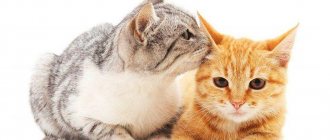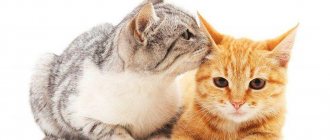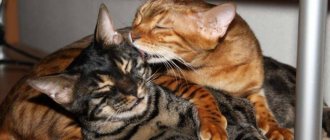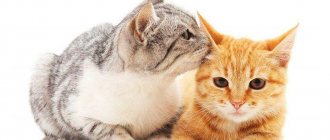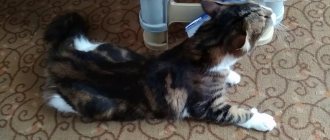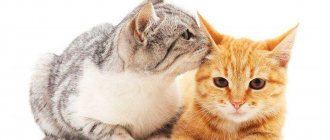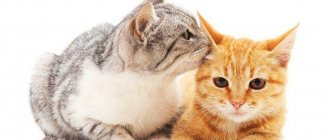How to tell if a cat is pregnant at home
Gestation by a cat lasts 58-70 days.
The period depends on the breed, age, number of fruits. The first signs of pregnancy in the first week are hidden, after two to three weeks of fertilization the first symptoms appear: toxicosis, drowsiness, frequent urination, changes in the mammary glands and behavior.
Cat behavior during pregnancy
During pregnancy, a cat undergoes a restructuring of the body, and morning sickness appears. The animal becomes lethargic, refuses food, outdoor games, communication with the owner, and visits the litter box more often.
Toxicosis is a temporary phenomenon, so the female’s appetite soon returns to normal and in some places increases. Taste preferences also change. The expectant mother asks for what she previously refused: raw meat, cheese, butter, olives. If there is a lack of vitamins, a cat may chew plaster, wires, or eat its own fur.
A pregnant pet, having gotten used to the situation, eventually becomes affectionate, requiring more attention and care.
Termination of heat
Cats go into heat differently. It occurs either once every three months and lasts up to 20 days, or once a month and lasts 3-5 days. Can a pregnant cat go into heat? Definitely no.
Typically, fertilization after mating occurs within 20-45 hours. Once conception has occurred, estrus stops. The female stops calling the cat, does not arch her back, does not roll on the floor, and calms down.
Abdominal rounding
You can tell if a cat is pregnant by looking at its belly. Starting from the 5th week, it becomes rounded and dense, located behind the ribs. At week 6, the growth of the abdominal cavity increases: an experienced veterinarian will determine the number of fetuses by palpation.
Rapid enlargement of the abdomen begins at 8 weeks. It lowers, positioning itself closer to the hips. By placing your hand on your stomach, you can feel the kittens moving.
Swelling of the nipples
Two weeks after mating, the cat's nipples become bright pink and enlarge due to hormonal changes. After 7 weeks, the hair surrounding the nipples partially falls out.
3-5 days before the birth of kittens, the mammary glands produce colostrum.
Growing up
Usually the first heat occurs at the age of 11-12 months. The presence of hormonal changes leads to the fact that estrus occurs much earlier. For example, facts of the appearance of estrus in 5-6 month old kittens were recorded, and pregnancy may already occur at this age. Such early fertilization is fraught with pathologies, because the mother cat’s body is still developing, and pregnancy is a huge burden that is difficult for a teenage kitten to cope with.
Experts advise not to allow cats with early onset of estrus to be mated. It is believed that this tendency is a hereditary problem. If your pet is in heat before the age of 8 months, this is a deviation from the norm. The same applies to late estrus. If an animal has not had estrus after one and a half years, it must be shown to a veterinarian.
Empty heats can harm the health of the ward. Purulent diseases of the uterus that occur against the background of frequent empty estrus require the help of a veterinarian, and in some cases the animal dies without surgery.
X-ray of a pregnant cat as a diagnostic method
An X-ray image is used to identify the pathology of an animal’s pregnancy, count the number of embryos, and assess the quality of health of future offspring. The skeletons of kittens are visible after 44 days of fertilization.
In the early stages, x-rays are not indicated, since the image will only capture the tissue of the uterus.
The procedure involves the correct position of the cat: on its side or on its back. This position allows you to count the number of kittens by correlating the number of skulls and spines.
Determining if a cat is pregnant using ultrasound
Ultrasound of a cat during pregnancy is a common, painless and quick way to determine the period and problems of bearing offspring. The study will allow timely recognition of deteriorating animal health.
Diagnostics helps to see embryos as early as 2 weeks of pregnancy. After 4 weeks, the specialist will determine the exact number of kittens, check the activity of their hearts, and the condition of the cat itself. The movement of the fetuses is recorded, body parts and internal organs of the kittens are recognized. By the end of the 8th week, it is important to determine whether the amount of amniotic fluid is decreasing: the kittens are swallowing liquid. Reducing water levels and the size of the fetuses help the specialist determine the estimated due date for the pet.
Nutritional Features
Nutritional needs change throughout pregnancy. The first two weeks, when appetite increases slightly, the daily portion is increased by 10%. In this case, the entire volume of food is divided not into 2 meals, as usual, but into 4–5. From 3 to 7 weeks, the amount of feed is doubled from the original. Over the last fortnight, my appetite has decreased slightly as the fruits put pressure on my internal organs.
There should be no food from the human table, especially those containing chemical additives - chips, sausages, smoked meats, including fish. This is harmful to all domestic animals, and their benefits for humans are questionable.
Dry or natural food?
Cat breeders have not yet come to a consensus on which food is better - industrial or natural. But they agree on one thing: if it is ready-made food, then it must be the highest quality available. Switching to a different type of diet will do more harm than good.
Dry food familiar to cats is gradually being replaced with analogues for pregnant women. If a special product cannot be found, then simply increase the portion as described above. Experienced breeders recommend special foods for pregnant cats:
Royal Canin Queen
Interesting! Feline nutrition experts sometimes recommend feeding kitten foods instead of regular food from the first days of pregnancy and several weeks after birth as an adequate source of protein and energy.
In addition to the main diet, from time to time you can pamper your cat with natural products - meat, cottage cheese, yogurt. But then this is a delicacy, not the main food.
Many sources on cat nutrition note that it is not worth giving additional vitamins and minerals, since everything necessary is included in the product. Only a veterinarian can determine the possible need for supplements.
Natural nutrition
Breeders pay special attention to the natural nutrition of the cat.
Table 2. Qualitative composition of the diet of a pregnant cat.
Cats usually refuse plant foods. But if you grind it in a blender to a puree and mix it with meat products, then its taste buds can be deceived. You should not cut food into cubes, since only meat pieces will be selected from the plate.
A cat needs the following products:
- dietary meat - chicken, veal, beef (can be raw, but only fresh and high quality);
- sometimes - boiled fish;
- eggs - 2 pcs. in Week;
- low-fat dairy group - cottage cheese, yogurt, sour cream, cream, yogurt;
- cereals - oatmeal, rice, buckwheat;
- jelly, boiled cartilage.
Natural products are necessary for a pregnant cat
For constipation, give the cat beets and increase the amount of vegetable fat. But they are excluded or the dose is reduced after the condition has stabilized.
Attention! It is believed that animals are able to recognize what is harmful or spoiled by smell. This is just a myth. Therefore, it is necessary to ensure that only fresh and high-quality products are supplied to the pregnant woman’s table.
Herbal remedies for pregnant cats
Breeders recommend giving cats an infusion of raspberry leaves. It is prepared from a tablespoon of dry raw materials and a glass of boiling water, left for 15 minutes and filtered. Give a tablespoon 2 times a day from the beginning to the end of pregnancy. This will help bear healthy offspring and simplify the birth process.
In the second half of pregnancy, pre-scalded nettle leaves are added to the drink. These greens promote milk production.
Vitamin supplements for a pregnant cat
It is necessary to ensure the presence in the diet of vitamins A, D, E, B1, B6, B1, as well as calcium, phosphorus, iron, iodine. Taurine, a sulfur-containing amino acid, is extremely important. If the diet is prepared correctly and is not monotonous, the body receives most of these elements from food. But with an unbalanced diet, vitamin preparations with the listed substances are necessary.
The following brands offer vitamin complexes for pregnant cats:
- Beaphar (Top 10 Cat, Salvical, Irish Cal);
- Brewers Yeast 8 in 1;
- Anivital FeliImmun and others.
How to determine how far along a cat's pregnancy is
The gestational age of a cat is determined taking into account the following characteristics:
- 2-3 weeks: nipples turn pink, swell, activity decreases, appetite disappears, morning vomiting, drowsiness;
- 4-5 weeks: the belly is rounded, increasing in size, appetite increases;
- 6-7 weeks: weight gain by 1.5-2 kg, the belly grows faster, being located closer to the hips, the cat becomes affectionate, requiring increased attention;
- 8-9 weeks: the belly goes down, a significant weight gain, the kittens are felt moving, the cat begins to worry, tries to be closer to the owner, looks for a secluded place of birth, lies more, eats a lot, often goes to the litter box, nipples secrete colostrum.
How to detect a false pregnancy in a cat
The condition of a false pregnancy in a cat is not uncommon. More often, sphinxes, oriental cats, rexes, and Siamese are subject to it, inheriting the vice from their parents.
False pregnancy is a condition in which an unfertilized cat experiences symptoms of pregnancy.
Causes of abnormal behavior:
- mating occurred with a sterile/castrated or sick cat;
- the female’s genitourinary system is disrupted;
- the cat has congenital hormonal disorders, in which a false pregnancy occurs without mating with a male.
False pregnancy is classified as a mental illness in animals.
Signs of false pregnancy:
- lethargy, increased sleep duration, increased anxiety;
- alienation or persistent begging for human affection;
- finding a place to give birth;
- caring for a sock, a soft toy, carrying it in your teeth like a kitten;
- frequent licking;
- slight discharge from the genitals and nipples;
- rounding, thickening of the abdomen;
- enlargement of the mammary glands;
- surges in appetite;
- improper functioning of the gastrointestinal tract;
- slight increase in body temperature.
Ultrasound diagnostics will make it possible to more accurately determine a false pregnancy.
Preparing for childbirth
Often pets give birth so quietly and carefully that the owner does not even have time to notice any traces of the event. But in case of complications, the pet may need human help, so it is better to find out in advance how to determine that a cat is giving birth and carefully prepare for this event.
By the end of the third trimester of pregnancy, a caring owner should stock up on items and medications that may be useful during childbirth, as well as immediately after it. So, if you are worried about the health of your pet and her future children, you should definitely have on hand at the time of lambing:
- Oxytocin is a drug that stimulates labor in case it is delayed.
- Sterile latex gloves.
- Sterile scissors and thread.
- Antiseptic agents in powder and liquid form intended for animals.
- Zelenka and cotton balls for treating the umbilical cord.
- A special suction, bulb or pipettes to remove fluid from the kitten’s respiratory tract if it begins to choke.
- Clean terry towels for drying kittens.
- Phone veterinarian for urgent consultation.
- Cat milk replacer (she may not get it).
- A durable cardboard box for kittens with low sides (it doesn’t matter whether you buy it at a pet store or make it yourself - the main thing is that the cat can freely “travel” from and to it without disturbing the kittens).
How to detect a frozen pregnancy in a cat
Frozen pregnancy is a common phenomenon in which one or all embryos die in utero. This happens due to hormonal imbalances, infectious diseases, various pathologies of the body, poisoning with chemicals and drugs. In severe cases, miscarriage or death occurs due to infection of the body with cadaveric poison.
Ultrasound can detect non-viable embryos. If a pathology is detected, labor is stimulated. The problem cannot be delayed: a dead fetus is susceptible to decomposition, leading to infection of the cat’s body.
If live kittens are found, the pregnancy is not terminated. Dead fetuses will be released naturally during childbirth.
If a frozen pregnancy recurs, then the question of castration of the female arises.
Pregnancy in cats has some peculiarities that every breeder needs to know. The onset of fertilization and high-quality gestation of offspring is facilitated by puberty and the age of the female, depending on the breed, care, and climate. The optimal age for mating is 1.5 years.





